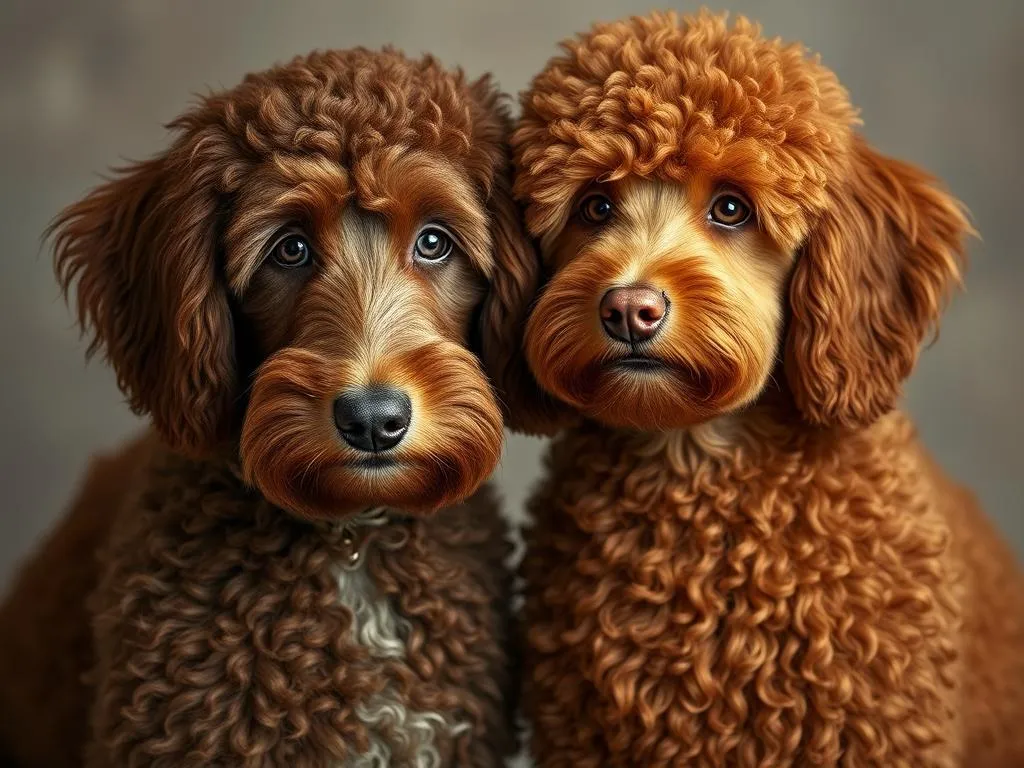
Understanding dog breeds is essential for potential dog owners, as each breed comes with its unique set of characteristics, temperament, and care requirements. Among the various breeds, red and brown Poodles stand out for their intelligence, elegance, and distinct appearance. Poodles have gained immense popularity worldwide, often ranking among the top breeds in various countries. This article will explore the fascinating world of Poodles, focusing particularly on the red and brown varieties, and provide a wealth of information for anyone considering adding one of these delightful dogs to their family.
Overview of Dog Breeds
Definition of Dog Breeds
A dog breed is a specific group of domestic dogs that share common traits, including physical characteristics, temperament, and behavior patterns. Breeding practices can be traced back thousands of years when humans began domesticating wolves, selectively breeding them for desirable traits. This process has led to the vast array of breeds we see today, each adapted for various purposes, from herding and hunting to companionship.
Importance of Breed Characteristics
Understanding breed characteristics is crucial for dog ownership. These traits affect not only the physical appearance of the dog but also its behavior and temperament. For instance, some breeds are known for their high energy levels and require more exercise, while others may have a calmer demeanor, making them suitable for quieter households. Recognizing these traits helps potential owners choose a dog that complements their lifestyle and ensures a harmonious relationship.
Popularity of Poodles
Poodles are among the most popular dog breeds, consistently ranking high in various surveys and breed registrations. Their intelligence, hypoallergenic coats, and versatility make them appealing to dog lovers. According to the American Kennel Club, Poodles are frequently found in the top ten list of most popular dog breeds. Their unique coat colors, including red and brown, contribute to their charm and allure.
Understanding Poodles
History and Origin of Poodles
The Poodle’s history can be traced back to Germany, where it was originally used as a water retriever. The name “Poodle” is derived from the German word “Pudel,” which means “to splash in water.” Over time, the breed spread across Europe, particularly in France, where it became a popular companion dog for aristocrats. Poodles have undergone various transformations throughout their history, leading to the development of the three distinct sizes we recognize today.
Types of Poodles
Poodles are categorized into three main types based on size:
-
Standard Poodle: The largest of the three, Standard Poodles stand over 15 inches at the shoulder and are known for their athleticism and intelligence.
-
Miniature Poodle: Standing between 10 to 15 inches tall, Miniature Poodles are known for their playful nature and adaptability to various living environments.
-
Toy Poodle: The smallest variety, Toy Poodles measure under 10 inches at the shoulder. They are affectionate and make excellent companions, especially in smaller living spaces.
General Characteristics of Poodles
Poodles are known for their curly, hypoallergenic coats, which come in various colors, including red and brown. They are intelligent, eager to please, and highly trainable, making them suitable for various roles, including service dogs and therapy animals. The average lifespan of a Poodle ranges from 12 to 15 years, but they can be prone to certain health issues, including hip dysplasia and eye disorders. Regular veterinary care is essential to ensure their well-being.
Red and Brown Poodles
Color Variations
One of the most distinguishing features of Poodles is their coat color. The genetics behind the red and brown Poodles can be complex. Red Poodles are often seen as vibrant and energetic, while brown Poodles are appreciated for their rich, chocolate hue. The perception of these colors varies among dog enthusiasts, with some favoring the striking appearance of red Poodles, while others prefer the classic elegance of brown Poodles.
Care and Grooming Needs
Grooming is an essential aspect of caring for red and brown Poodles. Their curly coats require regular grooming to prevent matting and maintain coat health. Here are some grooming tips:
-
Grooming Schedule: It’s recommended to groom your Poodle every 4 to 6 weeks, depending on their coat length and maintenance needs.
-
Tools: Use a slicker brush and a metal comb to detangle their fur. A good quality pair of grooming scissors or clippers will help maintain their coat length and style.
-
Skin Care: Poodles can be prone to skin issues, so regular baths with a gentle, hypoallergenic shampoo are advisable. Always ensure their skin is dry and free from moisture to prevent infections.
Training and Socialization
Poodles are known for their intelligence, making them relatively easy to train. However, early training and socialization are crucial for developing well-rounded dogs. Here are some training tips for red and brown Poodles:
-
Positive Reinforcement: Use treats and praise as rewards to encourage good behavior. Poodles respond well to positive training techniques.
-
Socialization: Expose your Poodle to various environments, people, and other animals early on. This helps them develop confidence and reduces the likelihood of behavioral issues later in life.
-
Common Issues: Poodles may exhibit stubbornness or separation anxiety if not properly trained. Consistent training and gradual acclimatization to being alone can help mitigate these issues.
Health Considerations for Poodles
Common Health Issues
Like all breeds, Poodles are susceptible to certain health problems. Some common health concerns include:
-
Hip Dysplasia: A genetic condition that affects the hip joint, potentially leading to arthritis.
-
Progressive Retinal Atrophy (PRA): A degenerative eye condition that can lead to blindness.
-
Addison’s Disease: A hormonal disorder that can affect Poodle health, particularly in older dogs.
It’s essential to be aware of these issues, especially for red and brown Poodles, as certain genetic factors may influence their likelihood of developing these conditions.
Preventative Care
Regular veterinary check-ups play a crucial role in maintaining your Poodle’s health. Recommended preventative care includes:
-
Routine Check-Ups: Schedule annual visits to the vet for physical exams and vaccinations.
-
Health Screenings: Discuss with your vet the appropriate screenings for common Poodle health issues, especially as your dog ages.
Nutrition and Diet
Proper nutrition is vital for the overall health of Poodles. Their dietary needs may vary based on their size and activity level. Here are some nutritional guidelines:
-
Balanced Diet: Choose high-quality dog food that meets the nutritional needs of your Poodle’s age and size. Look for foods rich in proteins, healthy fats, and essential vitamins.
-
Weight Management: Poodles can be prone to obesity, so monitor their weight and adjust their food portions accordingly. Regular exercise is also essential.
Lifestyle Compatibility
Ideal Living Conditions
Poodles are adaptable dogs that can thrive in various living conditions. Whether you live in a spacious house or a cozy apartment, red and brown Poodles can adjust to their environment. However, they do require a certain amount of space to move around and play.
Exercise Requirements
Poodles are energetic dogs that need regular exercise to stay healthy and happy. Daily walks, playtime, and mental stimulation through puzzles and games are essential. Here are some engaging activities for Poodles:
-
Fetch: A great way to exercise and bond with your Poodle.
-
Agility Training: Poodles excel in agility courses, providing both physical and mental stimulation.
-
Swimming: Given their history as water retrievers, many Poodles enjoy swimming, making it an excellent way to exercise them.
Family Compatibility
Poodles are often excellent family dogs. Their friendly nature and intelligence make them suitable for households with children. They tend to get along well with other pets, provided they are socialized from a young age. It’s essential to supervise interactions between young children and dogs to ensure safety for both parties.
Finding the Right Poodle
Adoption vs. Breeding
When looking for a Poodle, prospective owners have the option of adopting from a shelter or purchasing from a breeder. Each choice has its pros and cons:
-
Adoption: Rescuing a Poodle from a shelter can be a rewarding experience. Many dogs in shelters are already trained and socialized, providing a loving home for a dog in need.
-
Breeding: If you prefer a specific size or color, researching reputable breeders is essential. Ensure that the breeder follows ethical breeding practices and prioritizes the health of their dogs.
Preparing for a New Poodle
Before bringing a red or brown Poodle home, it’s crucial to prepare adequately. Here are some essential supplies:
-
Food and Water Bowls: Invest in non-slip bowls that are easy to clean.
-
Leash and Collar: Choose a comfortable collar and a sturdy leash for walks.
-
Bedding: Provide a cozy bed for your Poodle to rest and sleep.
Creating a welcoming environment will help your new companion adjust smoothly.
Conclusion
Choosing the right dog breed is a significant decision that requires careful consideration of various factors, including lifestyle, space, and personal preferences. Red and brown Poodles make excellent companions, known for their intelligence, adaptability, and affectionate nature. They can thrive in different living situations and are generally great with families and other pets. As you embark on your journey to find the perfect Poodle, remember to consider not only the breed’s characteristics but also your own lifestyle and the commitment involved in dog ownership.









